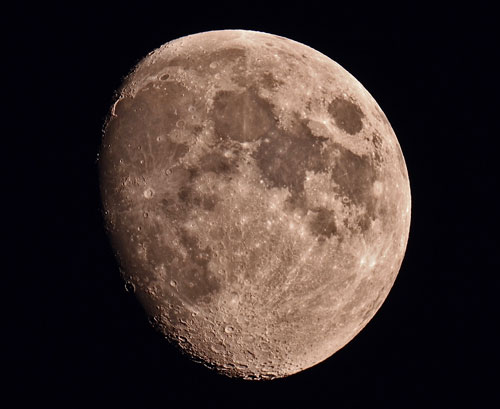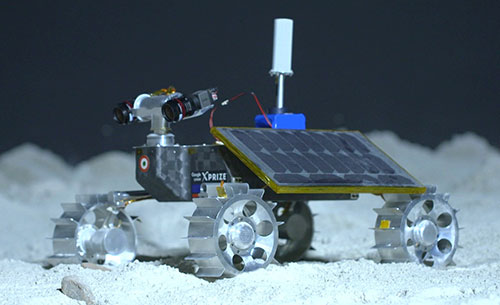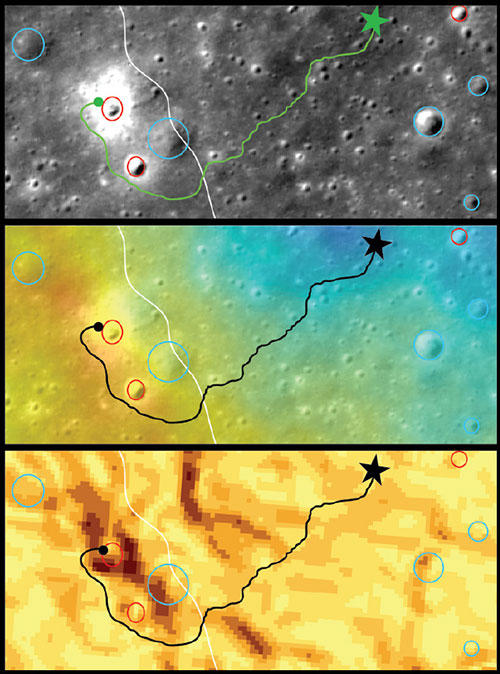PROVIDENCE, R.I. [Brown University] — Next year, the private space firm ORBITBeyond hopes to put its first lander and rover on the surface of the Moon. The small but capable vehicle, dubbed “ECA,” will send photos and stream live video back to Earth as it explores the Mare Imbrium, a sprawling volcanic plain on the Moon’s nearside.
As part of their work in a planetary science course, a team of student researchers from Brown University is working with the company to consider what scientific questions that little rover might help to answer. In consultation with ORBITBeyond engineers and using the technical specs for ECA, the students spent last semester devising a design reference mission — a detailed template for what the real mission might ultimately look like. The group of 14 graduate students and a few undergrads scoped out landing sites, planned possible rover traverses and delivered their recommendations to ORBITBeyond.
For the students, many of whom hope to one day plan space missions for a living, the project was a chance to apply what they’ve learned about lunar science to an actual Moon mission.
“Being involved at this stage in our careers with an actual mission that’s going to fly is an experience I don't think we could get elsewhere,” said Ashley Palumbo, a Ph.D. student in the class and one of the leaders of the project. “It’s just a great opportunity.”

For ORBITBeyond, it was a chance to work with young researchers who are tuned into the very latest in lunar science.
“We were thrilled to delve into the scientific importance of our Imbrium landing site and how what we engineer can greatly enhance scientific output of the mission,” said Jatan Mehta, science officer at TeamIndus, a partner of ORBITBeyond's that was instrumental in designing the ECA rover.
“We believe such low barriers to collaboration will motivate more students to participate in space exploration,” added Adithya Kothandhapani, a systems engineer at TeamIndus. “Scientists and engineers working together are the future. We can't wait to do more.”
The collaboration is also drawing praise from top NASA officials. Late last semester, the students had a chance to present their work to Sarah Noble, a program scientist in NASA’s planetary sciences division (and a Brown alumna), and Thomas Zurbuchen, associate administrator for NASA’s Science Mission Directorate. They were impressed with what they saw.
“As commercial companies are becoming an important element of our exploration infrastructure, it is critical for scientists, and especially young scientists, to learn how to collaborate with these new partners to the benefit of all,” Zurbuchen said. “I only wish there were more classes like this around academia.”
Big science, little rover
TeamIndus, an India-based group of engineers, originally designed the lunar lander and ECA rover for this mission while vying for the Google Lunar XPRIZE. The prize was to go to the first private company to land on the Moon, rove 500 meters and return high-definition video of the traverse. TeamIndus’s rover was one of five finalists, but the prize ultimately went unclaimed. TeamIndus’s partnership with ORBITBeyond, one of NASA’s private partners vying for contracts to fly cargo to the Moon, means that ECA (which stands for Ek Choti si Asha, Hindi for “a small hope”) is getting a new chance to fly.
Jim Head, a professor in Brown’s Department of Earth, Environmental and Planetary Sciences, had worked with TeamIndus during their XPRIZE mission planning. He thought he might be able to keep that collaboration going by incorporating the rover’s new mission into a class he was offering called The Origin and Evolution of the Moon.

The question he wanted the students to consider was this: What kind of science can be done with a rover that was designed largely with engineering objectives in mind? The rover doesn’t have any sophisticated scientific equipment, but it does have an array of cameras. What useful information might those cameras reveal?
“Over the course of the semester, we discussed the current state of knowledge in lunar science,” Palumbo said. “We outlined the questions that are still unanswered, and then started thinking about how this mission might help answer them.”
The Imbrium Basin turns out to be a good place to learn about the Moon’s volcanic history. The basin was flooded billions of years ago by lava, which cooled to form the rocky surface covering the basin today. ECA’s cameras will give an up-close view of that surface that’s impossible to get from orbital instruments. For example, scientists will be able to look at and characterize the texture and grain size of the rock, which provides information about the conditions in which the lava cooled. They can also look at how porous the rock is, an indicator of how much gas was present in the lava when it erupted.
Much of the rock covering Imbrium is derived from lava that flowed to the surface around 3.5 billion years ago — the Moon’s volcanic prime. But interspersed within the most ancient flows are flows that erupted more than a billion years later, during the dying days of the Moon’s volcanic activity. Seeing how those oldest and youngest deposits differ could provide valuable information about how the Moon’s interior changed over time. The students carefully mapped areas within the ORBITBeyond landing ellipse where these different lava flows meet and planned a rover traverse that crosses them.
“If we can traverse across the flow fronts, going from one flow front to another, we can see what the transition between them is like,” said Ariel Deutsch, a Ph.D. student in the class and the co-leader of the project with Palumbo. “That gives us an idea of how the characteristics of the lava changed from the early volcanic episodes to the waning stages of volcanism.”
Also included in the proposed rover route is a pass by a relatively young impact crater. The crater wall should expose how layers of solidified lava flows are situated atop each other and their relative thicknesses, which helps scientists to reconstruct the sequence and duration of volcanic events.
As the students planned their design reference mission, they corresponded with ORBITBeyond and TeamIndus engineers to make sure their plans were feasible.
“They made sure we took into account certain engineering constraints,” Deutsch said. “For example, there are only solar panels on one side of the rover, which means you can only drive certain directions at certain times of day. So we had to have discussions about what that means for integrating science activities into traverse planning.”

At the end of last semester, the students presented their work to ORBITBeyond and were pleased with the reaction.
“I don’t think any of us realized how important our contribution might be until the final weeks of the class when we got to present to ORBITBeyond,” Palumbo said. “We had a teleconference with them that ended up lasting two-and-a-half hours and they were really interested and had lots of great questions about how to move forward.”
And the collaboration didn’t end there. The students and ORBITBeyond engineers will present their design reference mission next month at the 50th Lunar and Planetary Science Conference (LPSC) in The Woodlands, Texas. And the two groups say they’ll continue to collaborate as the mission’s proposed 2020 launch date draws nearer.
A new era in space exploration
NASA’s Zurbuchen says that part of the reason this course was so important is that it comes at a time of transition in space exploration. Going to space used to be an enterprise limited to government space agencies, but that’s changing in a hurry. Companies like SpaceX and ULA have been making deliveries to the International Space Station for several years now. And last year, NASA announced its Commercial Lunar Payload Services program, a partnership with nine private firms — one of which is ORBITBeyond — to send critical cargo to the lunar surface in the coming years.
And while planetary scientists are used to working with government partners, working with private partners is a challenging new frontier, says Zurbuchen.
“Such work requires great understanding of the top-notch science, but also an understanding of the commercial entities and their motivations and constraints,” Zurbuchen said. “[It also] requires seamlessly crossing … boundaries between science, engineering and other disciplines. The project at Brown is a great example of training and research to support the objectives of this new exploration campaign, and especially to understand the interests of commercial exploration partners, and to maximize science that can come from such a novel approach.”
And it wasn’t just the Brown students who benefitted. Brown is home to one of NASA’s Solar System Exploration Virtual Institutes (SSERVI), which sponsored the class. Through SSERVI, scientists from around the world could listen in on the class and participate in discussion online.
Next month, Brown’s SSERVI collaboration will continue exploring partnerships between scientists and the private space industry. Brown and SSERVI will sponsor a symposium in Texas coinciding with LPSC that brings scientists from around the world together with NASA’s Commercial Lunar Payload Services partners and other private space firms. Head, who is one of the symposium’s organizers, says that the collaboration between his students and ORBITBeyond will serve as an important example of how such partnerships can work. Palumbo and Deutsch are among the symposium’s presenters.
“It’s critically important that everybody involved learns to navigate this new terrain,” Head said. “We scientists need to know what opportunities commercial missions offer to do new science, and it’s good for the companies to interact with the scientists who will be their clientele moving forward. These partnerships are going to enable transformative lunar science in the years to come.”